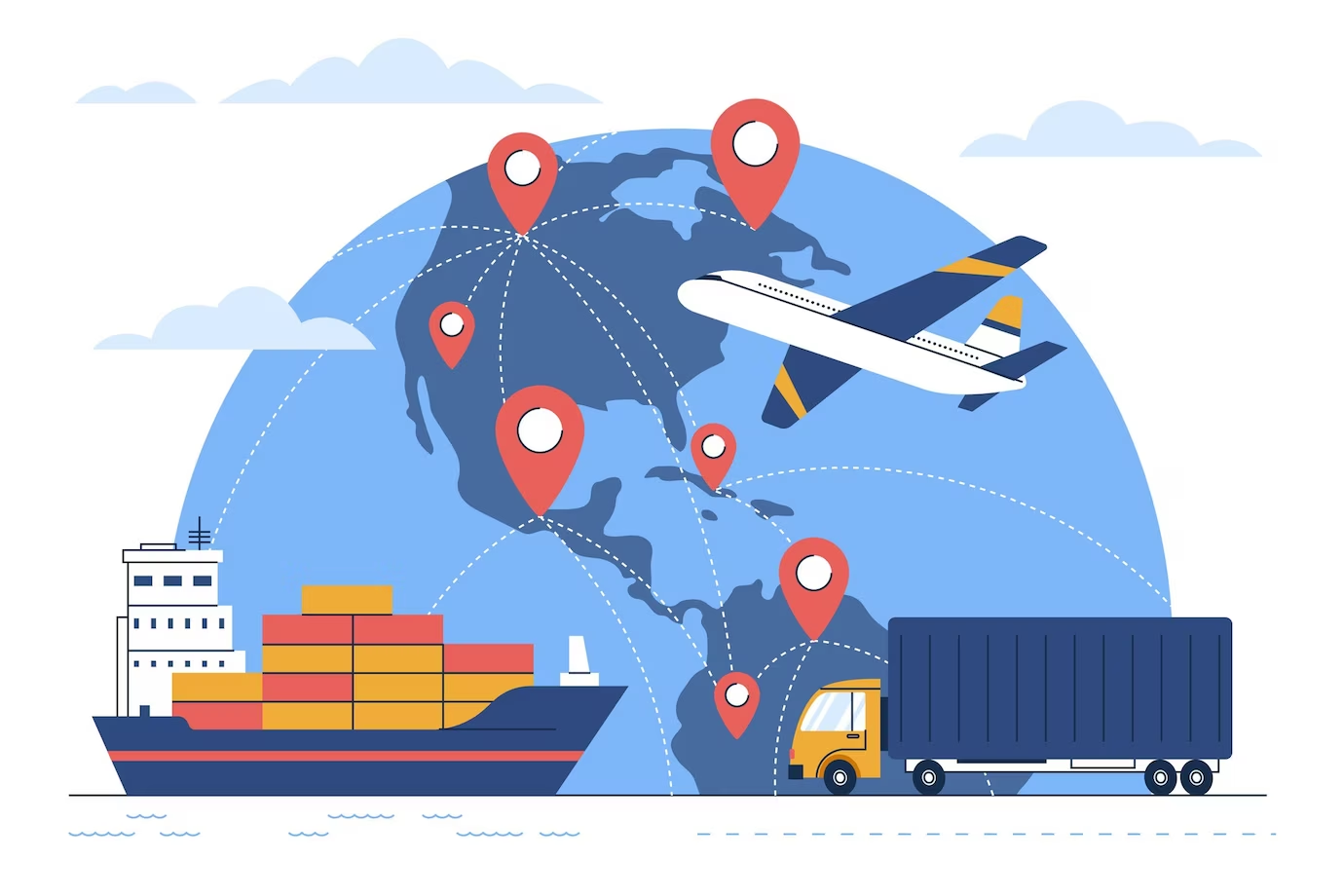Distributed Order Management: Mastering Multi-Channel Fulfillment

Source: FreePik
As eCommerce continues to grow at a rapid pace, managing orders across multiple channels can become an overwhelming task. It’s important to get this right, because how you manage a large volume of customer orders will make or break your business.
Customers don’t care about the back end processes required to fulfill orders. They simply expect products to be in stock, arrive within a reasonable amount of time, and be free from issues.
If your order fulfillment isn’t operating like a well-oiled machine, you risk decreasing customer satisfaction, and in a competitive niche like eCommerce, you need all the wins you can get.
Whether you’re a dropshipper or manage a growing eCommerce store, a large influx of orders can easily cause chaos. Selling across multiple channels, like your own website and platforms like Amazon, can quickly become overwhelming.
To keep up, you need the right tools on your side. With orders coming in from different platforms, warehouses, and vendors, keeping track of inventory levels, shipping statuses, and customer information can be challenging.
This is where a distributed order management (DOM) system comes in.
Learn what a DOM platform is, how it differs from traditional options, why it’s so helpful, and how you can find the right distributed order management solution for your business.
What Is a Distributed Order Management System?
A DOM is a tool that allows you to process orders more efficiently. Most DOM solutions have advanced rules built into the platform to help you route orders and streamline the entire supply chain for your business.
A DOM software platform can manage orders and inventory across multiple sales channels, warehouses, and vendors. It enables businesses to receive, process, and fulfill orders from different channels in a unified way.
DOM systems integrate with various sales channels, such as marketplaces, online stores, and brick-and-mortar locations, as well as with inventory management systems, shipping carriers, and payment gateways.
The system ensures customers receive the quality experiences they desire—without overwhelming your business. When implemented correctly, it becomes a real win-win solution.
In essence, a DOM system serves as a central hub for all order and inventory information, providing businesses with complete visibility and control over their operations. The system can automatically route orders to the most suitable warehouse or vendor based on factors like inventory availability, shipping costs, and delivery timeframes.
DOM solutions usually come with several features, including:
🔶 Automated communications
Create certain triggers or rules for automated communication with customers at scale. For example, you can automatically send a buying guide to people who purchase specific items.
🔶 Order routing
Send orders to the best fulfillment center for the job. For example, you might use a local fulfillment center for shoppers on the East Coast to speed up shipping times, reduce costs, and minimize the potential for damaged goods.
🔶 Capacity management
Route orders to the most suitable facility. This is especially helpful during the busy holiday shopping season when certain fulfillment centers might experience a surge in orders.
🔶 Cost management
Manage order routing, shipping rates, and other costs to make your business more profitable over time.
🔶 Syncing
If you’re selling on multiple channels, a DOM will synchronize inventory data across all channels—including physical storefronts—to give you more inventory visibility.
Depending on the DOM you’re using, you can also use the platform to merge orders, process payments, track orders, manage suppliers, and collaborate with third-party logistics (3PLs) companies.
The breadth of functionality might seem excessive, but below, we’ll explore why DOM systems are the way to go.
Why Do You Need a Distributed Order Management System?
In the ever-evolving landscape of eCommerce, customer expectations for quick delivery and order accuracy are high.
As an eCommerce store owner, you’ve probably come to the realization that the legacy systems that served you well when selling via a single channel or eCommerce platform may no longer meet your growing needs. Larger fulfillment networks are necessary to keep up.
This is where order management software steps in. These systems help eCommerce stores navigate and manage the entire fulfillment process.
For dropshipping businesses, which rely on suppliers to ship products directly to customers, a DOM system becomes even more vital.
Retail DOM software bridges the gap between the retailer, supplier, and customer, ensuring that the retailer can maintain control over the customer experience without holding physical inventory.
How Is Distributed Order Management Different from Traditional Order Management?
As we mentioned earlier, traditional systems are good for managing orders and keeping track of inventory in just one place or warehouse. When it comes to selling via multiple channels, these systems often fall short.
DOM systems, on the other hand, are specifically designed for businesses that sell in more than one way. They can do everything a traditional system can, but they're also equipped to handle orders and inventory from many places, like online stores, social media, and physical shops.
This means you can put all your orders from different places into one system, making things a lot easier and less likely to get mixed up.
These systems are really popular with big online businesses that sell on lots of platforms or across multiple countries.
But they're also a smart choice for smaller online businesses. Starting with a DOM system can make the process of growing your business smoother and help you avoid some common problems as your business expands.
Here’s a table that explores the key differences between traditional order management and DOM:
|
Traditional Order Management |
Distributed Order Management |
|
|
Supply Chain Model |
Bulk buying from brands to brick-and-mortar stores |
Sourcing inventory from multiple fulfillment locations |
|
Inventory Management |
Static, with limited visibility |
Real-time visibility of inventory across suppliers and channels |
|
Flexibility and Agility |
Static and less flexible |
Agile and adaptable to dynamic demands |
|
Technology and Infrastructure |
On-premise, heavy architecture, often outdated |
Cloud-based, web service integrations, modern infrastructure |
|
Data Accuracy |
Limited accuracy, potential for errors |
Up-to-date and accurate inventory information |
|
Ordering Process |
Bulk ordering on a regular basis |
Ability to place smaller, frequent orders across platforms |
|
Efficiency and Productivity |
Operational efficiency is limited due to disjointed processes |
Increased due to streamlined and integrated processes |
|
Customer Experience |
Potentially negative due to stockouts and shipping inefficiencies |
More positive due to efficient inventory and shipping management |
|
Challenges |
Difficulty with inventory counting, shipping optimization, and avoiding stockouts |
Real-time inventory tracking, optimized shipping rules, better stock management |
Now that you're familiar with the differences between DOM and traditional order management systems, let's delve into the various fulfillment options available with a DOM system.
These options offer diverse and efficient ways to manage your inventory, catering to the unique needs of your business. In the next section, we'll explore each of these options in detail, helping you understand how they can enhance your inventory management and overall order fulfillment process.
Components of a Distributed Order Management System
In DOM, there are three main components you can use to handle your customers' orders.
You don’t need to use all of them; evaluate each element before deciding which one(s) are best for your company.
1. Third-party logistics (3PLs)
Using third-party logistics providers involves outsourcing your warehousing and fulfillment processes to external service providers. When integrated with a DOM system, 3PLs offer visibility across multiple warehouse locations.
Benefits for your business
➡️ Enhanced shipping capabilities: Enables faster shipping, as 3PLs are often strategically located to reduce delivery times
➡️ Direct selling opportunities: Allows you to sell directly to customers, bypassing distributors—especially beneficial when your order volumes increase
➡️ Dropshipping support: Facilitates dropshipping fulfillment, where your retail partners sell your products, and you ship them directly to customers—this can open doors to new retail partnerships and market testing opportunities
2. Dropshipping fulfillment model
In dropshipping, you don't keep the products you sell in stock. Instead, a retail partner that sells your product ships it directly to the customer.
Benefits for your business
➡️ Lower inventory risk: Expand your product offerings without the risk of holding inventory
➡️ Efficient testing of new products: Quickly test new brands and product lines without significant upfront investment
➡️ Access to more products: Gain access to a broader range of products from wholesalers and brands, enhancing your catalog
3. “Ship from store” & “buy online, pick up in store” (BOPIS)
“Ship from store” means customers order online and get their items shipped from a nearby store, while BOPIS allows customers to buy online and then pick up their order at a store.
Benefits for your business
➡️ Leveraging physical stores: Compete more effectively with online retailers by using physical stores for fulfillment, making it more efficient
➡️ Reduced shipping costs: Save on shipping costs, especially residential deliveries, while increasing profit margins
➡️ Enhanced customer experience: Offers customers the convenience of easy returns and pickups, encouraging more online purchases
Benefits of a Distributed Order Management System for eCommerce Businesses

As eCommerce businesses grow, they often need to manage orders across multiple sales channels, warehouses, and vendors.
Without a DOM system, this can quickly become an overwhelming task, leading to errors, delays, and low customer satisfaction. If you’re on the fence about DOM systems, consider all of the benefits they offer eCommerce brands:
✅ Run a more agile business
As your eCommerce business grows, managing orders across multiple channels can become difficult. A DOM system allows you to scale your operations to multiple platforms—and way more customers—without sacrificing efficiency or accuracy.
A DOM platform also provides analytics and insights into your business. It needs to gather a lot of data to do this, but a DOM can help you run a more profitable, agile business over time.
As a bonus, you can easily adjust your DOM rules to align with both customer expectations and how you want your platform to work. Just modify your logic settings, and you’re good to go.
✅ Find more flexible fulfillment options
A DOM system makes it easy to route orders, split orders, and ship goods more efficiently. These platforms will help you choose the best fulfillment option for each sale, and they can even offer options like BOPIS to give your shoppers the flexibility they crave.
✅ Increase visibility
You can integrate your systems into one intuitive dashboard with the right DOM tool to keep track of inventory.
A DOM system provides businesses with a centralized platform for managing orders and inventory across multiple channels. This reduces the need for manual processes like data entry and eliminates the risk of errors when managing orders across multiple platforms.
✅ Save time
A DOM system enables businesses to maximize order fulfillment by automatically routing orders to the most appropriate warehouse or vendor based on factors like inventory availability, shipping costs, and delivery timeframes.
This can reduce shipping times and costs, leading to happier customers and improved profitability.
Plus, if you’re running your business solo, DOM software automates many finicky tasks. For those with employees, it takes a lot of tasks off their plate, allowing them to focus on what matters most: serving your shoppers.
✅ Save money
Did you know that proper order management can trim costs? DOM software can reduce the cost of shipping by routing each individual order to the most competitive shipping option.
It can also help prevent stockouts and overstocking, so you always have the right amount of inventory to fulfill every order.
✅ Reduce errors
Without a DOM, you have to do a lot of fulfillment work manually, potentially creating errors. Automating and streamlining your business will remove the potential for making expensive errors and the chaos they cause.
✅ Improve the shopper experience
If shoppers have a great experience buying from you, they’re more likely to return again and again.
With a DOM system, businesses can give customers real-time visibility into their order status, shipping information, and tracking numbers.
This improves the customer experience, increasing customer loyalty and repeat customer purchases.
How to Find a Distributed Order Management System for Multiple Sales Channels

Implementing a DOM system for multiple sales channels can seem daunting, but it doesn't have to be. Follow these simple steps to find the right DOMS for your eCommerce store:
Know your goals
Why do you need a DOM system? What are you going to use it for? Are you looking for cost optimization or time savings?
Every platform is different, so you must define your goals to find the right platform for your needs.
Look at your current inventory management practices. What’s working? Where could you improve? If you’re trying to choose between a few different systems, it’s important to consider which options best align with your priorities—so, always start with your goals first.
List your technical requirements
How many products can a DOM system support? Does it limit the number of suppliers you can work with? What types of analytics do you need?
Every eCommerce store does things a little differently. A DOM system is only effective if it integrates with the sales channels you’re already using, so ensure that your DOM system can integrate with the marketplaces, stores, and physical locations you already have.
Ask vendors for demos
Don’t commit to a DOM platform without testing it first. Quality platforms will be more than happy to give you a trial before you buy.
At a minimum, you should consider these features:
➡️ Integration with various sales channels that you currently have or plan to have
➡️ Inventory management that gives you a high-level view of inventory across all channels
➡️ Customer data storage that helps you learn more about your shoppers
➡️ Ease of integration with your existing systems, ability to provide real-time visibility into order and inventory information, and ability to scale as your business grows
Ease of use is also a factor to consider here. It might sound like a low priority, but choosing an intuitive DOM can speed up your time to value. That means you spend less time scratching your head in training and more time generating a return on your investment.
Integrate with your DOM system
Once you decide on a DOM system for your store, make sure you set it up correctly. You’ll need to create all of the essential integrations for everything to work properly.
A DOM system should integrate with your business's inventory management system to ensure accurate inventory levels across all sales channels. This integration should include real-time updates of inventory levels, product information, and pricing.
You also need to set up rules for order routing. A key feature of a DOM system is the ability to automatically route orders to the most appropriate warehouse or vendor based on factors like inventory availability, shipping costs, and delivery timeframes.
You should set up rules to determine how orders are routed to ensure efficient and cost-effective order fulfillment.
Don’t forget to integrate your system with your shipping carriers, too. This will streamline shipping by automating shipping labels, tracking numbers, and delivery notifications.
Spark Shipping: Modern Distributed Order Management for Omnichannel Sellers

eCommerce order fulfillment can be a struggle, which is why so many businesses opt for a DOM solution. DOM is becoming increasingly popular among dropshippers and eCommerce brands because sellers need help managing a large number of orders on multiple platforms.
DOM is a vital tool for eCommerce. If you’re looking for a centralized platform for managing orders and inventory, improving order fulfillment, and enhancing the customer experience, Spark Shipping is the right option for you.
Spark Shipping’s intelligent automated order fulfillment tool helps businesses manage orders more efficiently.
✔️ Use one-to-many mapping to link one product to multiple vendors so you stay in stock and source the best-priced product for every order.
✔️ Easily track the stock keeping units, quantities, and unit costs for all vendors in one place.
✔️ Automatically route orders to the best supplier. Spark Shipping can send orders to your supplier in any format, too.
Spark Shipping helps eCommerce businesses save hundreds of hours a month, all while boosting sales. See the difference for yourself: get a Spark Shipping demo now.
Popular Posts
Posts by Topic
- Dropshipping (5)
- Dropshipping Automation (4)
- Dropship Suppliers (3)
- EDI (3)
- Pricing Strategy (3)
- Amazon Seller Central (2)
- Conversion Rate Optimization (2)
- Dropshipping Products (2)
- Order Management (2)
- Vendor Product Catalog (2)
- Dean Soto (1)
- Feature Announcement (1)
- Online Empire Academy (1)
- Product Optimization (1)
- Shipping (1)
- referral marketing (1)